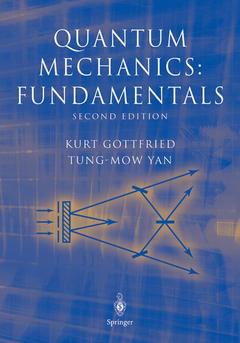Description
Quantum Mechanics: Fundamentals (2nd Ed., 2nd ed. 2003)
Graduate Texts in Contemporary Physics Series
Authors: Gottfried Kurt, Yan Tung-Mow
Language: English
116.04 €
Subject to availability at the publisher.
Add to cart
Quantum mechanics: fundamentals, (2nd Ed.)
Publication date: 06-2003
622 p. · 15.5x23.5 cm · Hardback
Publication date: 06-2003
622 p. · 15.5x23.5 cm · Hardback
84.39 €
Subject to availability at the publisher.
Add to cart
Quantum mechanics : Fundamentals, (2nd Ed.)
Publication date: 07-2004
622 p. · 17.8x25.4 cm · Paperback
Publication date: 07-2004
622 p. · 17.8x25.4 cm · Paperback
Description
/li>Contents
/li>Comment
/li>
Quantum mechanics was already an old and solidly established subject when the first edition of this book appeared in 1966. The context in which a graduate text on quantum mechanics is studied today has changed a good deal, however. In 1966, most entering physics graduate students had a quite limited exposure to quan tum mechanics in the form of wave mechanics. Today the standard undergraduate curriculum contains a large dose of elementary quantum mechanics, and often intro duces the abstract formalism due to Dirac. Back then, the study of the foundations by theorists and experimenters was close to dormant, and very few courses spent any time whatever on this topic. At that very time, however, John Bell's famous theorem broke the ice, and there has been a great flowering ever since, especially in the laboratory thanks to the development of quantum optics, and more recently because of the interest in quantum computing. And back then, the Feynman path integral was seen by most as a veryimaginative but rather useless formulation of quantum mechanics, whereas it now plays a large role in statistical physics and quantum field theory, especially in computational work. For these and other reasons, this book is not just a revision of the 1966 edition. It has been rewritten throughout, is differently organized, and goes into greater depth on many topics that were in the old edition.
Fundamental Concepts.- The Formal Framework.- Basic Tools.- Low Dimensional Systems.- Hydrogenic Atoms.- Two-Electron Atoms.- Symmetries.- Elastic Scattering.- Inelastic Collisions.- Electrodynamics.- Systems of Identical Particles.- Interpretation.- Relativistic Quantum Mechanics.- Index.
Builds a solid introduction to the concepts and techniques of quantum mechanics in settings where the phenomena treated are sufficiently simple: systems that can either be solved exactly or be handled by well-controlled, plausible approximations Includes discussions of many-electron atoms, the electromagnetic field, and the Dirac equation Includes supplementary material: sn.pub/extras
© 2024 LAVOISIER S.A.S.




